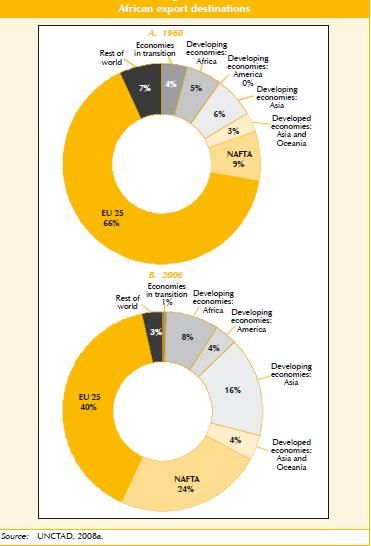What happens when trade liberalization is not followed by reforms in structural and institutional constraints? Well, the level and composition of exports will not change and will lead to decrease in market share as foreign goods and services flood domestic market, which lacks strong industrial background. According a report from UNCTAD, trade liberalization in Africa in the past 25 years has led to decrease in market share for world exports from 6% in 1980 to 3% in 2007. Moreover, there is barely any headway in the level and composition of exports.
The report highlights that despite trade liberalization, the African countries have not diversified their exports towards more dynamic primary commodities and manufacturing goods, which are less prone to the vagaries of international markets. The report attributes Africa’s weak supply response as the most important impediment to the continent’s export performance. It recommends that future export policies should focus more on way to increase production for export.
In a way the report declares that the structural adjustment programs, spearheaded by the IMF and the WB, in Africa was a complete failure. By 1985, 60% of African countries were under the SPAs and by 1995, almost all the African nations were under the such programs. The result after two and a half decades: dismal performance in the very sector the reform programs were supposed to help Africa grow! The Washington Consensus was an utter failure in Africa.
Export diversification is very low in Africa. African countries remain principally primary commodity exporters and the dependence of African countries on a small number of export products has increased in the period following liberalization. Many countries in the region are at present less able to withstand price shifts for a few key commodities than they were prior to liberalization.
The tide of trade liberalization (cut high taxation and “getting prices right”)was expected to increased production of tradables, generate positive externalities for the economy by improving efficiency of production, generate substitutions effect so that price of imported inputs were lower and thus promote exports by increasing production, increase investment both from domestic as well as foreign investors, etc. However, huge subsidies in the US and EU on agricultural sector basically wiped off the African agricultural base because cheap products not only displaced African agriculture production in the market but also created disincentives among farmers to engage in agriculture, leading to high dependence rate on foreign food aid and imports.
Production and marketing costs increased during liberalization, with the removal of subsidies and currency devaluations, while the dissolution of marketing boards added price risks to the uncertainties of rain-fed agriculture. The consequence is that much of Africa continues to be dependent on traditional bulk agricultural commodities for a major share of its export earnings. Paradoxically, African countries have been losing market share to other developing countries even in exports of these commodities.
The report recommends increase in public investment in R&D, including roads and irrigation facilities, health and education. Also, facilitating access to inputs, encouragement of new investment, and better access to market information would help improve overall efficiency in agricultural trade. The point that remains unanswered is: how much of a damage does subsidies inflict on agriculture development in Africa.
For the manufacturing sector the report recommends to:
- increasing firm competitiveness at the economy level and at the firm level
- encouraging establishment of large manufacturing firms
- facilitating access to credit to invest and foster firm growth
- creating a framework of interaction between financial institutions and private sector
The report states that trade liberalization should not be seen as an end in itself; it should be a subset of a comprehensive developments strategy. Focus should be shifted back to the development strategies that are consistent with the development challenges and priorities of African countries.
